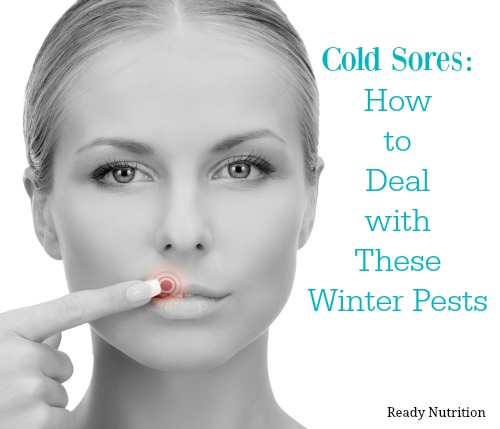
The information herein details conditions of cold sores, as well as the mention of several naturopathic foods that may provide relief for sufferers. The information presented in this article is just that: for informational purposes only. The contents of this article and any actions herein are not meant to diagnose, treat, prescribe, or rectify any condition or malady discussed here. For questions or concerns pertaining to this information and actions outlined, please consult your doctor or family physician for their advice and approval.
The Ugly Truth About Cold Sores
Cold sores are also known as fever blisters. They are a form of the herpes simplex virus that occurs on the lips. The affliction’s scientific name is herpes labialis, or herpes on the lips, where the cold sores occur. The virus is the Herpes Simplex Virus 1, or HSV-1. The virus itself is a human DNA virus that causes recurring eruptions that are painful and embarrassing to the patient. Also present can be found vesicular eruptions (burst blisters, to phrase it commonly) that leak exudates that are infective and thereby can be transmissible to others. During the cold weather months, they surface more regularly and due to a weakened immune system often accompany illnesses such as the common cold or the common flu.
After making initial contact with the skin, the virus travels in the body along the nerve fibers until reaching the sensory ganglia. In this location the virus establishes a latent infection. Latency means the infection is not active but is lying hidden within the tissues and cells. There are certain stimuli that may activate the virus, such as sexual contact, exposure to UV radiation, illnesses characterized by fever, and stress/anxiety. Such stimuli may cause the affliction to resurface and travel back to the site of original infection.
A rash with a red base, upon which can be noticed groups of tiny blisters, characteristically identifies cold sores. Prescription medications to treat outbreaks and/or prevent recurrences are Acyclovir, Famciclovir, and Valacyclovir. They are also effective antiviral agents and analgesics. You will need to seek a doctor’s care to obtain them.
What To Do When Symptoms Manifest
There are some steps to be taken when confronted with HSV-1/cold sores either when you have them or are with another person who does:
- When the lesions do manifest themselves, avoid any skin-to-skin contact
- The sufferer may wish to use a soft toothbrush, as well as mouthwashes with saline or bicarbonate
- Oral anesthetics may be employed (over-the-counter)
- Consume soft foods
- Use lip balm with sunscreen; this helps to decrease oral lesion recurrence
Natural Ways to Alleviate Cold Sore Symptoms
There are a couple of naturopathic foods that can help to alleviate the symptoms and discomfort with cold sores.
Scarlet Pimpernel (Anagallis arvensis) is used medicinally. The dried, flowering herb sans roots is the therapeutic part of the plant. Scarlet Pimpernel is antiviral, and the aqueous extract of the dried leaves is fungitoxic. The methanol extract of the dried, powdered drug is antiviral, specifically to HSV-1, the organism responsible for the cold sores. It can be administered topically as a poultice and/or internally as an infusion. The dosage is 1.8 grams of powder taken 4 times per day. Orally (as per infusion) take 5-10 drops or 1 tablet per day.
Follow the manufacturer’s instructions if purchasing it in a health food store.
Scarlet Pimpernel can also be administered as an ointment 1-2 times per day. Be advised that the herb is a strong diuretic, is a diarrheic, and is mildly narcotic at higher dosages. The herb is beneficial against a variety of other influenza viruses as well.
Thuja (Thuja occidentalis) is a second herb that is effective against cold sores. Thuja is actually a tree that grows 36-60 feet in height. The medicinal parts are the oil extracted from the leaves and branch tips, the young dried branches, and the fresh leafy branches. The tree is found in Eastern North America and is harvested for medicine in the spring. Dosages must be followed strictly, due to Thuja’s tendency to cause spasms with high dosages of the essential oil, as well as convulsions, metabolic disturbances, and renal disturbances.
Thuja is used in conjunction with antibiotics to treat bacterial conditions of the skin and with Herpes simplex infections. Thuja is a powerful antiviral, not to be taken lightly. The use is contraindicated with pregnant women. The official thujone (a constituent of Thuja) toxicological limit is 1.25-mg/kg body weight. Dosages are as such: for extracts – 1:1, 50% ethanol, or 1:10, 60% ethanol, both given 1-2 ml three times daily. Tincture is given as 100 parts Thuja powder to 1000 parts diluted spirit of wine (EB6).
To summarize, both of these herbs are very serious. Dosage recommendations of the manufacturer in preparations must be followed to the letter! You can find these herbs either in commercial preparations or as the raw herb in your better health food stores. As an adjunct to the salves, these will actually work on the offending organism, and aid you in your battle with a wintertime visit from the cold sores. May your trips and excursions be happy and safe, and you have a great day!
JJ

Sun chlorella placed against the gum and inner lip works wonders, at least for me it does. It tends to arrest the spread and discomfort of the sore, and heals quickly.
I always thought The Scarlet Pimpernel was an old B&W movie (that I have on DVD) Never knew it was an herb. I’m going to research it and stop at the local herb shops and see if I can find it.
Thank’s for the info…